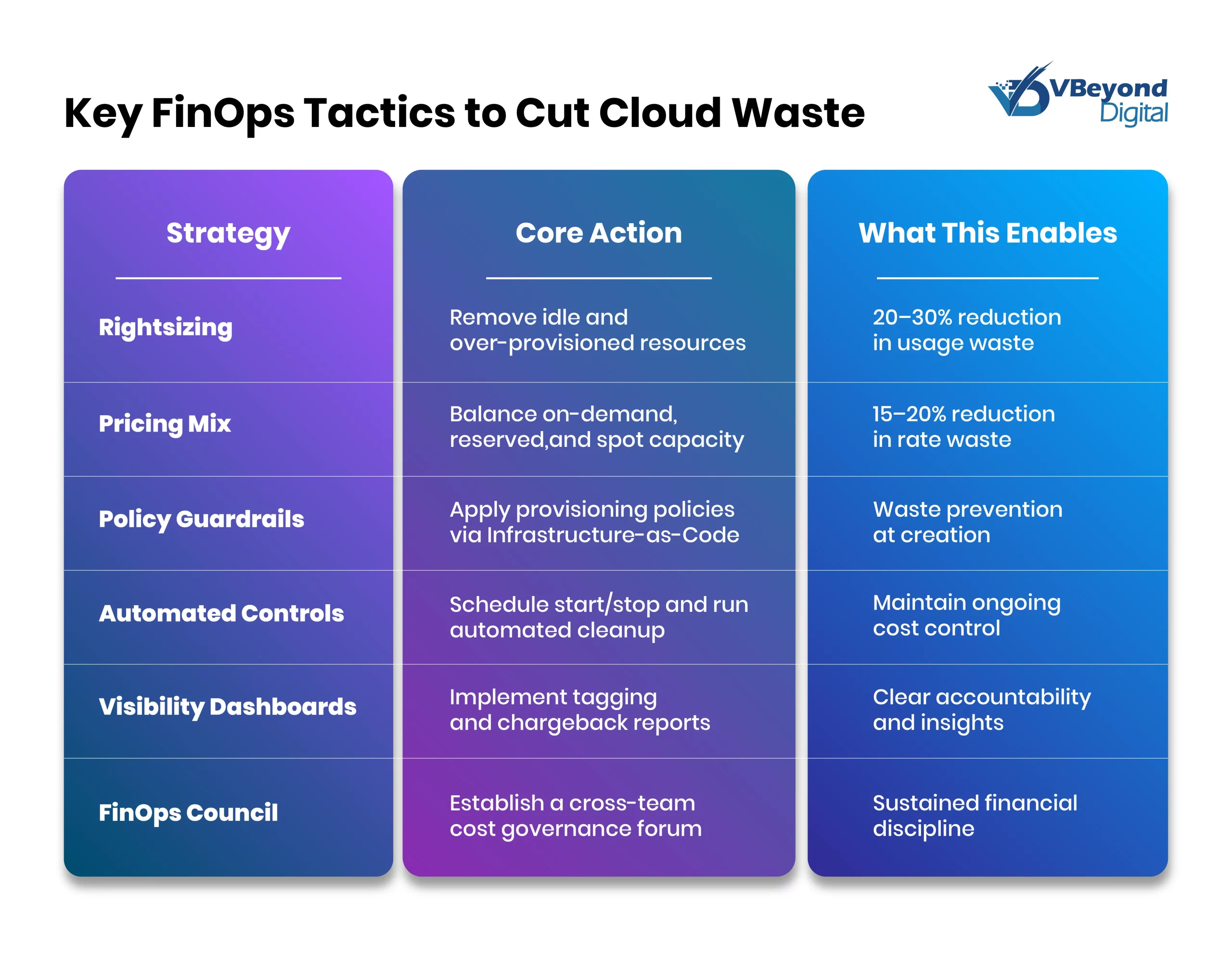How Can FinOps Strategies Help Cut Cloud Waste?
Section
- Cloud Waste Impact: Enterprises typically lose 20 – 30% of public cloud spend to idle resources and pricing mismatches.
- Core Principles: Shared ownership across finance, engineering, and operations; real‑time cost visibility; and policy‑first governance.
- Actionable Tactics: Right size compute and storage; balance reserved commitments with on‑demand pricing; and automate governance for controlled spending.
- Business Outcomes: Realize up to 30% savings and improve forecasting accuracy by following a structured cloud cost optimization roadmap.
The global cloud computing market size is estimated to reach $912.77 billion in 2025, and many enterprises are quietly losing 20–30% of their own cloud budgets to idle resources, overprovisioned capacity, and mismatched pricing models. This ends up shrinking margins, reduced agility, and unpredictable operating costs that hold innovation back.
To curb these rising complexities, corporations and enterprise cloud users are turning to FinOps, a framework that fuses financial discipline with engineering and operations. FinOps is more than simple cost-cutting; it’s about taking a shared ownership approach, enabling real-time visibility of cloud resource consumption, and policy-driven governance that ensures every cloud dollar delivers measurable business value.
Assessing and Quantifying the Problem
Enterprises across industries often see their public cloud budgets drained by unused capacity, overprovisioned compute and storage, and poorly managed pricing commitments. These inefficiencies stem from oversized virtual machines, idle storage volumes, and the absence of automated decommissioning processes for non-production workloads.
Rate mismatches often arise when pay-as-you-go workloads replace more cost-effective reserved instances, or savings plans for sustained usage. This inefficiency leads to significant financial drain, constraining IT budgets, and limiting investments in high-impact products and platforms.
Limited real-time visibility and volatile forecasting compound the problem, creating budget unpredictability that can stall transformation initiatives.
On average, enterprises waste 20–30% of their total cloud spend, translating to millions in unnecessary annual costs.
Cloud waste falls into two broad categories:
- Usage waste: Idle instances, unattached storage, and underutilized compute nodes consuming resources without contributing to business value.
- Rate waste: Relying on full pay-as-you-go rates for workloads eligible for reserved instance discounts, committed use programs, or volume-based pricing models.
Unchecked, these inefficiencies not only inflate costs but also reduce forecast accuracy and delay critical project timelines. Manual cost management processes further burden engineering teams, diverting focus from innovation to operational firefighting.
Cut cloud waste with FinOps.
Core FinOps Principles
Successful implementation of FinOps strategies demands that ownership of each element of cloud cost management is decentralized across finance, engineering, and operational teams so that each group remains accountable for resource provisioning decisions, utilization patterns and cost outcomes.
This shared ownership approach ensures that engineers become mindful of consumption impacts, finance teams gain clarity on usage drivers, and product leaders can directly correlate cloud spend with customer value metrics.
Embedding accountability at the team level reduces delays in cost allocation, enhances decision‑making velocity on resource configuration trade‑offs, and aligns spending models with strategic business objectives.
- Shared Ownership: When every engineering group, finance analyst, and product manager take responsibility for their specific cloud consumption patterns and cost allocations, collaborations emerge and technical investments are mapped to measurable business outcomes aligning with a clear cloud cost optimization roadmap.
- Real‑Time Visibility: Consistent showback reporting, cost dashboards, and tagging‑driven reporting at near real‑time intervals empowers teams to detect usage anomalies, refine forecasting models and drive data‑driven resource adjustments before budgets overrun while supporting Azure cloud cost optimization initiatives.
- Policy‑First Governance: Implementing automated infrastructure as code policies and guardrail mechanisms at provisioning phases prevents over-allocation and enforces spending limits in line with cloud financial management requirements across all environments.
Tactical Strategies to Cut Waste
Organizations can employ targeted tactical approaches within their FinOps framework to actively minimize cloud waste and realign spending with actual workload demand and business priorities.
These methods empower technical and finance leaders to implement resource rightsizing, adjust pricing commitments, and automate governance in support of a robust cloud cost optimization roadmap that sustains operational performance.
Applying these cloud cost management tactics reduces budget overruns, improves forecasting accuracy, and delivers measurable savings that accelerate strategic IT, product, and platform initiatives without compromising reliability.
A. Right-Size and Rationalize Resources
- Identify and eliminate “zombie workloads” quickly by using automated scanning tools to detect idle virtual machines, unattached storage volumes, and stale snapshots that no longer support active business operations.
- Continuously align resource profiles with workload demands by analyzing utilization metrics. Resize instance types and storage tiers based on peak and average consumption patterns to maintain predictable cloud costs.
B. Optimize Pricing Commitments
- Balance pay-as-you-go usage with reserved instance commitments or savings plans using accurate usage forecasts. This approach secures lower rates for compute and storage services while preserving the agility needed for critical workloads within your FinOps strategy.
- Leverage spot or preemptible computing capacity for noncritical background and batch jobs. These workloads can tolerate interruptions and deliver up to 90% cost savings compared to on-demand pricing, supporting your broader Azure cloud cost optimization goals.
C. Automate Continuous Governance
- Integrate infrastructure-as-code and policy-as-code into CI pipelines to automatically remediate noncompliant resource configurations, preventing overspending at the provisioning stage.
- Set up scheduled instance start-stop actions and budget alert thresholds using native cloud billing tools and automation services. These measures enforce cost ceilings and provide proactive notifications when actual spend deviates from forecasts.
- Deploy AI-driven cost analysis engines to correlate usage logs, billing data, and performance telemetry. These systems detect anomalies, predict waste patterns, and recommend targeted adjustments across compute, storage, networking, and managed services.

Embedding FinOps into Your Organization
Embedding FinOps strategies into organizational processes requires integrating financial accountability, technical workflows, and governance policies to maintain continuous oversight of cloud expenditure and its alignment with corporate goals.
This initiative brings clarity to fiscal decision‑making by allocating cost ownership to specific teams, ensuring that each sprint, feature release or infrastructure change is evaluated for its cost implications before approval.
By adopting an operating model that bridges finance and engineering, enterprises gain a sustainable approach to cloud cost optimization, reducing manual interventions while maintaining agility for strategic innovation initiatives.
- Integrating FinOps workflows into CI/CD pipelines by embedding policy-as-code cost gates and real-time cost estimation into build and release stages ensures every deployment considers financial impact before resource provisioning actions occur.
- Establishing a FinOps Council with representatives from engineering, finance, product, and operations defines clear decision and accountability structures that guide cloud financial management and governance policies across business units.
- Implementing structured cost-review cadences and dedicated optimization sprints at monthly and quarterly intervals analyzes detailed consumption and spending patterns, identifies inefficiencies, and informs adjustments to a data-driven cloud cost optimization roadmap.
Lessons on Cloud Waste Reduction from Leaders
Quantitative outcomes from industry reports demonstrate how successful implementations of FinOps strategies deliver substantial cloud cost savings and reinforce the imperative for a structured cloud cost optimization roadmap.
Legacy re‑architecture – GE Vernova
GE Vernova transitioned critical workloads from on‑premises CapEx infrastructure to a pay‑as‑you‑go OpEx model on AWS, incorporating AWS Graviton processors and auto scaling to right‑size compute capacity dynamically.
In under twelve months the company achieved over one million dollars in cost savings, including six hundred thousand dollars from Graviton migration and one hundred thousand dollars by decommissioning idle instances, demonstrating the tangible benefits of shifting to cloud cost management best practices.
Automated controls – GlobalDots
GlobalDots implemented a suite of FinOps best practices, integrating real‑time alerting, budget threshold notifications, and scheduled instance start‑stop routines to enforce policy‑first governance across its cloud environment. By combining tagging governance with automated chargeback reporting and self‑service cost dashboards, the company lowered its monthly cloud bill by sixteen percent within four months while improving visibility and accountability for cost drivers.
End‑to‑end FinOps maturity – XenonStack
XenonStack’s client adopted a full FinOps framework spanning AWS, Azure, and GCP, embedding cost‑estimation gates in CI/CD pipelines and running monthly optimization sprints to align spending with strategic priorities. This end‑to‑end approach yielded a thirty percent reduction in cloud waste within six months across compute, network, and data storage services, illustrating the power of continuous efficiency improvements coordinated by a dedicated cloud cost management team.
The FinOps Roadmap for Leadership
Quick Wins (0–3 months)
- Standardize tagging policies and automate compliance checks.
- Decommission idle resources with automated tools.
- Set up budget alerts to catch cost variances early.
Mid-Term (3–9 months)
- Embed cost gates in CI/CD pipelines for automated enforcement.
- Commit to reserved instances or savings plans for predictable workloads.
- Develop centralized dashboards for unified cost visibility.
Long-Term (9+ months)
- Integrate financial goals into product roadmaps and planning cycles.
- Establish a cross-functional FinOps council for governance and accountability.
- Empower teams with self-service cost management tools and training.
Conclusion
By following the structured FinOps framework detailed in this guide, technology leaders can implement a cloud cost optimization roadmap that immediately identifies idle resources, eliminating up to thirty percent waste through rightsizing and automated governance workflows while aligning resource consumption with strategic business priorities.
Engage stakeholders today in a data‑driven dialogue that centers on waste percentage metrics, forecast variance insights, and cost allocation transparency to ensure your organization treats cloud financial management as a strategic enabler of business agility, not just a line item on the P&L.
Schedule a consultation with VBeyond Digital to apply FinOps strategies and reclaim wasted cloud budget with precision.
FAQs (Frequently Asked Question)
FinOps combines financial management and cloud operations to drive a collaborative model for Cloud cost management, enabling teams to allocate spend with precision and improve cost visibility. It underpins cloud cost optimization by defining metrics, empowering engineers and finance to apply FinOps best practices in real time for measurable ROI.
Start by assembling a cross‑functional FinOps team, conducting an initial cloud spend assessment, and defining your FinOps framework goals. Implement workflows for tagging, show back reporting, and budget alerts, then iterate on these FinOps strategies through regular reviews and planning sprints.
Track waste percentage to quantify idle-resource impact, forecast accuracy to measure budgeting reliability, resource utilization rate to identify overprovisioning, and discount coverage to ensure Azure cost savings through committed pricing. These KPIs guide your cloud cost optimization roadmap by highlighting inefficiencies and informing targeted spending adjustments.
FinOps tools range from broad FinOps platforms that support multiple capabilities to specialized solutions for rightsizing, chargeback, and anomaly detection. Native services like AWS Cost Explorer and Azure Cost Management integrate with third‑party offerings to deliver end‑to‑end cloud financial management visibility and help optimize cloud spend.
Embed policy‑as‑code cost gates and real‑time cost analysis into build and deployment stages to enforce budget guardrails before resource provisioning occurs. Adding checkpoints for budget alerts and tagging compliance within CI/CD workflows makes cost efficiency an integral part of your cloud delivery pipeline.
Common challenges include lack of cost ownership, siloed billing data, and manual processes. Establish a FinOps council to define accountability, centralize billing and usage logs on a FinOps platform, and automate cost controls via infrastructure‑as‑code policies to sustain your FinOps best practices.




